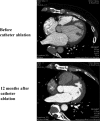Successful recovery of tachycardia-induced cardiomyopathy with severely depressed left ventricular systolic function by catheter ablation with mechanical hemodynamic support: a case report
- PMID: 27014440
- PMCID: PMC4771860
- DOI: 10.1002/ccr3.482
Successful recovery of tachycardia-induced cardiomyopathy with severely depressed left ventricular systolic function by catheter ablation with mechanical hemodynamic support: a case report
Abstract
We describe the case that persistent atrial fibrillation refractory to rhythm control by pharmacotherapy and electrical cardioversions caused tachycardia-induced cardiomyopathy with low ejection fraction and hemodynamic instability. Mechanical hemodynamic support using an intra-aortic balloon pump is one of the choices of hemodynamic support during catheter ablation by pulmonary vein isolation.
Keywords: Cardiogenic shock; clinical: catheter ablation – atrial fibrillation; intra‐aortic balloon pump; mechanical hemodynamic support; tachycardia‐induced cardiomyopathy.
Figures


References
-
- Umana, E. , Solares C. A., and Alpert M. A.. 2003. Tachycardia‐induced cardiomyopathy. Am. J. Med. 114:51–55. - PubMed
-
- Gupta, S. , and Figueredo V. M.. 2014. Tachycardia mediated cardiomyopathy: pathophysiology, mechanisms, clinical features and management. Int. J. Cardiol. 172:40–46. - PubMed
-
- Hsu, L. F. , Jais P., Sanders P., Garrigue S., Hocini M., Sacher F., et al. 2004. Catheter ablation for atrial fibrillation in congestive heart failure. N. Engl. J. Med. 351:2373–2383. - PubMed
-
- Sairaku, A. , Nakano Y., Oda N., Uchimura Y., Tokuyama T., Kawazoe H., et al. 2014. Incomplete cure of tachycardia‐induced cardiomyopathy secondary to rapid atrial fibrillation by heart rate control without sinus conversion. J. Cardiovasc. Electrophysiol. 25:1037–1043. - PubMed
Publication types
LinkOut - more resources
Full Text Sources
Other Literature Sources

